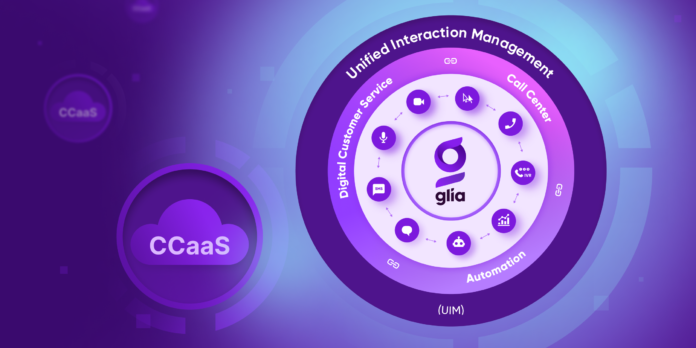In early 2023, Glia introduced Glia Call Center (formerly Glia Phone) to unify traditional phone and digital engagements within a single platform. By pairing traditional phone calls with Digital Customer Service (DCS) and the addition of virtual assistance, financial institutions can consolidate staffing, administration, and reporting, while offering a seamless customer experience across phone and digital channels.
This convergence has now propelled Glia beyond the traditional realm of CCaaS (Contact Center as a Service) to an emerging new category: Unified Interaction Management (UIM).
Understanding the value of shifting to UIM requires a clear distinction of exactly what it is, how it’s different from what existed before, and why those differences matter.
UIM and CCaaS Originated Differently
Virtually all companies have traditionally operated call centers to handle customer issues, which is why the earliest legacy vendors began by offering telephony-based on-premise software solutions. The better ones included routing and reporting capabilities, giving companies more control over how they managed incoming phone calls from customers.
The meaning of the term CCaaS began to morph from just Call Center as a Service, into the more digitally-inclusive category called Contact Center as a Service (still CCaaS but with a slightly different meaning). Most legacy vendors responded by replicating the same thing they were doing on-premises but using cloud technology and adding digital features and functions onto their existing telephony platforms, often through inorganic expansion by purchasing companies that had created new communication and collaboration tools. While necessary, this alone was insufficient.
The Original (and Ongoing) Disconnect
There is no question that Contact Center as a Service solutions were a big step up from Call Center as a Service solutions, this refreshed category started becoming increasingly obsolete in a digital-first world, for one fundamental reason: The individual channels in the CCaaS model are disconnected from each other. They are not integrated; they are bolted to each other in a fragile way that makes data sharing and channel switching frustrating for everyone involved, with each channel operated by separate “digital” teams, while the primary call center team continues on as before, handling phone calls.
For most customers, the experience of contacting a company by phone versus starting an interaction online, felt more like contacting two completely different companies. This friction caused by the disconnect between “the phone experience” and “the digital experience” is the leading cause of unnecessary high customer effort in a digital-first world–which we know translates into a double-whammy of higher costs and a sub-par, loyalty-harming customer experience.
The final step in this ongoing evolution, is a true rearchitecting of the platforms on which customer interactions are managed, and a new category of vendors altogether.
Unified Interaction Management: Built from the Beginning to Work Together
UIM eliminates the glaring gaps in the CCaaS experience. In the Unified Interaction Management model, all forms of communication and collaboration with customers are all seamlessly tied together in one single, cohesive platform. UIM is built on a ChannelLess® architecture–meaning, it doesn’t matter which “channel” a customer chooses to contact a company.
Whenever an interaction requires a transition from one form of communication to another (i.e. chat to voice), the experience continues seamlessly. Even if a customer needs to be upgraded to a specialized agent, the whole interaction continues seamlessly since there is no restarting or the necessity of re-explaining the customer’s issue.
In a UIM environment, one Interaction Team handles all incoming interactions from all customers, with the same sophisticated routing and even better escalation capabilities.
For managers in a UIM environment, reporting and orchestration is equally seamless. There is no such a thing anymore as a chat interaction, or a voice interaction, or an SMS (text) interaction. And by using the Interaction Needs Map, companies can now start matching exactly the right kind of interaction (messaging, voice, video, virtual assistance) to each customer’s need, which is what prompted them to want to interact with the company in the first place.
This represents the final step toward enabling organizations to finally achieve their preferred interaction mix, whether that’s more chat, more voice or more virtual assistance, taking control of tens of thousands of interactions in a way that is best BOTH for customers and for organizations.
UIM allows companies to dial in which interaction type to offer which customers and for which issues (sometimes automated, and other times human), in a way that will be best for the customer (more efficient, better experience) as well as for the company (cost savings, increased revenue, customer loyalty).
That’s the difference between CCaaS and UIM, and why this difference matters to your organization, and your customers.





